Transition zones between healthy and diseased retina in choroideremia (CHM) and Stargardt disease (STGD) as compared to retinitis pigmentosa (RP)
- PMID: 22076985
- PMCID: PMC3341121
- DOI: 10.1167/iovs.11-8554
Transition zones between healthy and diseased retina in choroideremia (CHM) and Stargardt disease (STGD) as compared to retinitis pigmentosa (RP)
Abstract
Purpose: To describe the structural changes across the transition zone (TZ) in choroideremia (CHM) and Stargardt disease (STGD) and to compare these to the TZ in retinitis pigmentosa (RP).
Methods: Frequency-domain (Fd)OCT line scans were obtained from seven patients with CHM, 20 with STGD, and 12 with RP and compared with those of 30 previously studied controls. A computer-aided manual segmentation procedure was used to determine the thicknesses of the outer segment (OS) layer, the outer nuclear layer plus outer plexiform layer (ONL+), the retinal pigment epithelium plus Bruch's membrane (RPE+BM), and the outer retina (OR).
Results: The TZ, while consistent within patient groups, showed differences across disease groups. In particular, (1) OS loss occurred before ONL+ loss in CHM and RP, whereas ONL+ loss occurred before OS loss in STGD; (2) ONL+ was preserved over a wider region of the retina in CHM than in RP; (3) RPE+BM remained normal across the RP TZ, but was typically thinned in CHM. In some CHM patients, it was abnormally thin in regions with normal OS and ONL+ thickness. In STGD, RPE+BM was thinned by the end of the TZ; and (4) the disappearances of the IS/OS and OLM were more abrupt in CHM and STGD than in RP.
Conclusions: On fdOCT scans, patients with RP, CHM, and STGD all have a TZ between relatively healthy and severely affected retina. The patterns of changes in the receptor layers are similar within a disease category, but different across categories. The findings suggest that the pattern of progression of each disease is distinct and may offer clues for strategies in the development of future therapies.
Figures

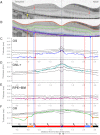
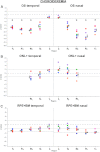
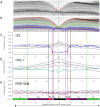
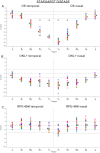

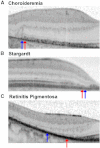
Similar articles
-
The transition zone between healthy and diseased retina in patients with retinitis pigmentosa.Invest Ophthalmol Vis Sci. 2011 Jan 5;52(1):101-8. doi: 10.1167/iovs.10-5799. Invest Ophthalmol Vis Sci. 2011. PMID: 20720228 Free PMC article.
-
Impact of segmentation density on spectral domain optical coherence tomography assessment in Stargardt disease.Graefes Arch Clin Exp Ophthalmol. 2019 Mar;257(3):549-556. doi: 10.1007/s00417-018-04229-3. Epub 2019 Jan 6. Graefes Arch Clin Exp Ophthalmol. 2019. PMID: 30613916
-
Natural History of the Central Structural Abnormalities in Choroideremia: A Prospective Cross-Sectional Study.Ophthalmology. 2017 Mar;124(3):359-373. doi: 10.1016/j.ophtha.2016.10.022. Epub 2016 Dec 13. Ophthalmology. 2017. PMID: 27986385 Free PMC article.
-
X-Linked Choroideremia.Adv Exp Med Biol. 2025;1467:43-49. doi: 10.1007/978-3-031-72230-1_9. Adv Exp Med Biol. 2025. PMID: 40736811 Review.
-
Optical coherence tomography in children with inherited retinal disease.Clin Exp Optom. 2024 Apr;107(3):255-266. doi: 10.1080/08164622.2023.2294807. Epub 2024 Jan 22. Clin Exp Optom. 2024. PMID: 38252959 Review.
Cited by
-
Rates of decline in regions of the visual field defined by frequency-domain optical coherence tomography in patients with RPGR-mediated X-linked retinitis pigmentosa.Ophthalmology. 2015 Apr;122(4):833-9. doi: 10.1016/j.ophtha.2014.11.005. Epub 2014 Dec 31. Ophthalmology. 2015. PMID: 25556114 Free PMC article.
-
Long-term natural history of visual acuity in eyes with choroideremia: a systematic review and meta-analysis of data from 1004 individual eyes.Br J Ophthalmol. 2021 Feb;105(2):271-278. doi: 10.1136/bjophthalmol-2020-316028. Epub 2020 May 29. Br J Ophthalmol. 2021. PMID: 32471821 Free PMC article.
-
Assessment of inner and outer retinal layer metrics on the Cirrus HD-OCT Platform in normal eyes.PLoS One. 2018 Oct 4;13(10):e0203324. doi: 10.1371/journal.pone.0203324. eCollection 2018. PLoS One. 2018. PMID: 30286099 Free PMC article.
-
Cellular and Molecular Mechanisms of Pathogenesis Underlying Inherited Retinal Dystrophies.Biomolecules. 2023 Feb 1;13(2):271. doi: 10.3390/biom13020271. Biomolecules. 2023. PMID: 36830640 Free PMC article. Review.
-
High-resolution adaptive optics retinal imaging of cellular structure in choroideremia.Invest Ophthalmol Vis Sci. 2014 Sep 4;55(10):6381-97. doi: 10.1167/iovs.13-13454. Invest Ophthalmol Vis Sci. 2014. PMID: 25190651 Free PMC article. Clinical Trial.
References
-
- Jacobson SG, Aleman TS, Sumaroka A, et al. Disease boundaries in the retina of patients with Usher syndrome caused by MYO7A gene mutations. Invest Ophthalmol Vis Sci. 2009;50:1886–1894 - PubMed
-
- Jacobson SG, Cideciyan AV, Sumaroka A, et al. Remodeling of the human retina in choroideremia: Rab escort protein 1 (REP-1) mutations. Invest Ophthalmol Vis Sci. 2006;47:4113–4120 - PubMed
-
- Lee TK, McTaggart KE, Sleving PA, et al. Clinical diagnoses that overlap with choroideremia. Can J Ophthalmol. 2003;38:364–372 - PubMed
Publication types
MeSH terms
Grants and funding
LinkOut - more resources
Full Text Sources
Medical

